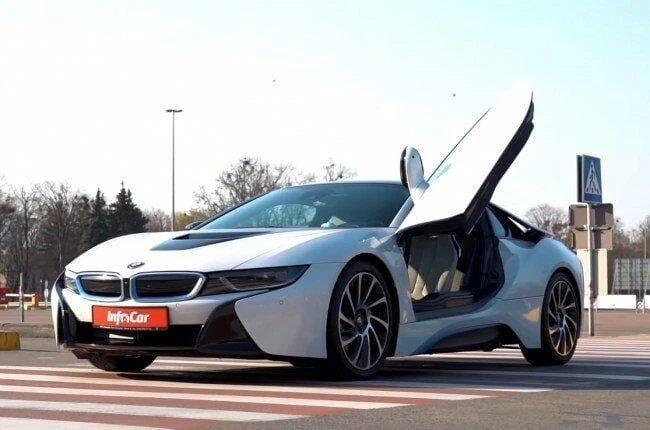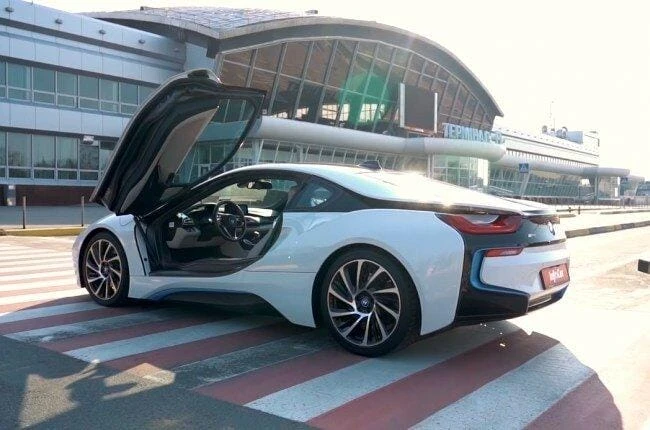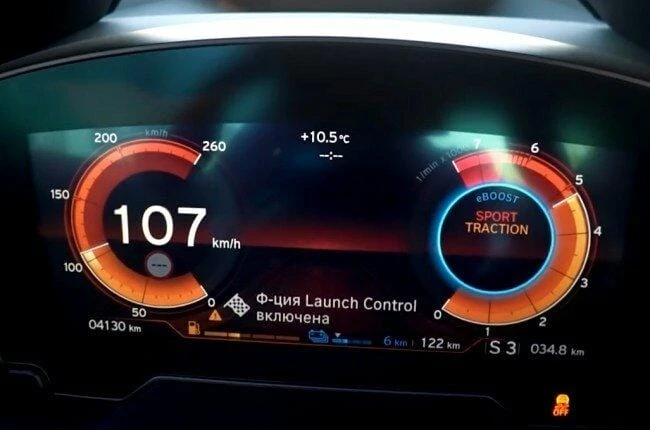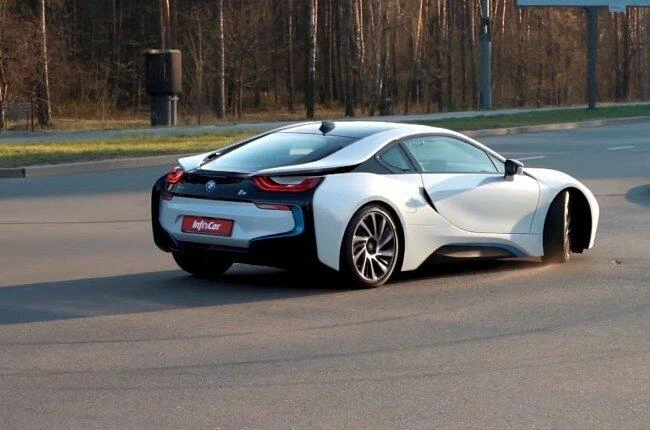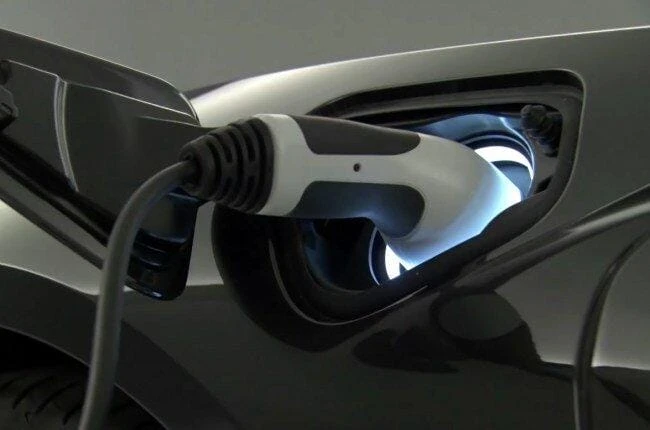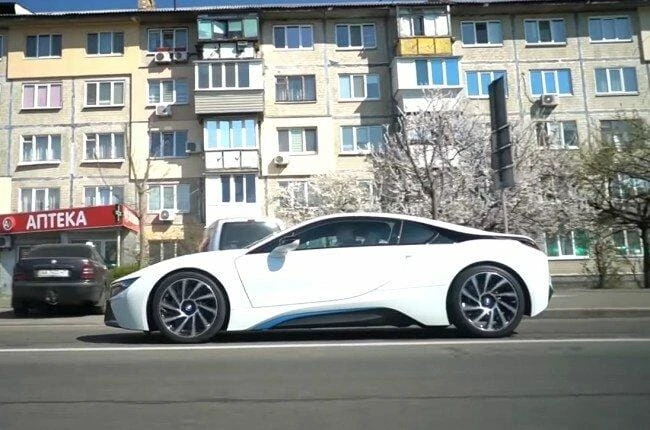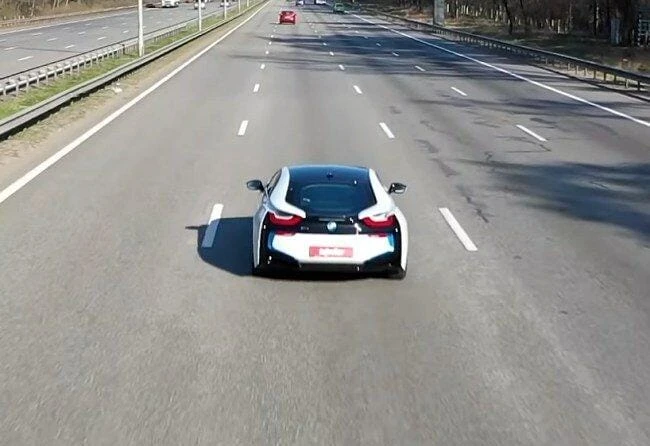BMW i8. The future left in the past
This year, the BMW i8 has been taken off the assembly line, and therefore I simply have to say goodbye to this extraordinary car. It would seem that during the time when the coupe was still produced, everything (or almost everything) should have been told about the i8. However, I found out the opposite: many have only heard about this model, and some do not even know what it is about when you start talking about this coupe.
Today I will try to answer all the remaining questions. We will also find out whether a car with a three-cylinder engine can be called a supercar, whether it is able to show good dynamics and at the same time consume 2 liters of gasoline per 100 km. And let's try to figure out whether this car is worthy of a price tag of 200 thousand dollars, and what it has in common with the Toyota Land Cruiser SUV.
Appearance
Some look impressive BMW i8, others consider it unsuccessful. I am one of the first, and I consider this design a masterpiece, which back in 2009… no, it didn't “ahead” the time, but stopped it. Even today, the i8 looks no less futuristic than its first concept (almost 10 years ago) in Mission: Impossible: Ghost Protocol. At the same time, the appearance of the coupe does not have that cloying, which is typical for such experiments when returning to them after a while. For 11 years, this car did not have time to become familiar and mix with the gray mass. It is still exclusive and makes passers-by turn around.
In my opinion, this is the most beautiful BMW in the history of the brand. Although you can make a more global statement: the Bavarians sometimes manage to create such unusual cars that they leave an imprint on the entire automotive history. These models include the 1979 BMW M1 and the 8 Series from the 1990s. I am also sure that the i8 can be safely put on a par with the indicated cars.
Most perceive the image of the i8 as a challenge, a challenge primarily to the fastest cars of the late 2000s. As a result, elation is usually followed by disappointment. After all, according to the characteristics and emotions from driving, this BMW, even during the official launch in 2014, was already losing to all those whom motorists considered its competitors. Even restyling in 2018 did not affect the situation. But here it is important to understand that i8 is not an ode to emotions, but a song of reason.
Story
In the early 2010s, BMW began work on this project not at all in order to overshadow the glory of the Lamborghini Gallardo, Ferrari 458 Italia, Porsche 911 Turbo and Mercedes SLS AMG. With the introduction of the “Efficient Dynamics” concept, the Bavarians sought to show their vision of the car of the future – first of all, environmentally friendly, economical and efficient. But to prove that such principles do not contradict dynamics and controllability has already become a kind of challenge for engineers. It is from this goal that the design of the i8 was born.
But the main thing is the fact that no matter how aggressive this design seemed to us, its main task was not to defeat rivals, but the air. The sophisticated forms of the car are not at all sick fantasies of designers, but the result of the work of engineers on aerodynamics, thanks to which it was possible to achieve a drag coefficient of 0.26 Cx. For that time (and now, too), this result was very good. The engineers decided that the car should not just cut through the air flows, but pass them through the body, reducing resistance and at the same time increasing downforce. This, in turn, compensated for the relatively low weight of the car, which is just over one and a half tons.
Technology
Many consider the i8 to be the slowest supercar. But, on the other hand, it is safe to say that we are dealing with the fastest “eco-hybrid”. Acceleration to the first 100 km / h takes only 4.4 s. For example, the F10 BMW M5 (introduced in September 2011) accelerated at the same rate.
Our measurements showed acceleration to 100 km / h in 4.7 s. We can assume that the passport figures were confirmed, and the lag is within the margin of error. But when you find out in more detail which engine is under the hood, you will be very surprised at this result.
So, the i8 is a plug-in electric-gasoline hybrid (really complex in terms of structure). The engineers had a very difficult task – to build a car with phenomenally low consumption at that time, a sufficient power reserve, while also providing it with the dynamics of a sports car. In addition, it was also necessary to keep the cost of i8 within certain limits. As you remember, in the late 2000s, no one took electric cars (including Tesla) seriously, in Germany, in particular. Therefore, the hybrid was a non-alternative option.
In order to combine efficiency and dynamics, it was necessary to work hard on the issue of reducing the weight of the car. But removing the excess, it was necessary not to forget about the comfort and functionality, which should have remained at the usual level for the luxury class. Therefore, it is not at all strange that the BMW i8 is perfectly equipped even by today's standards. It has everything you need (and even more): climate control, multiple displays, projection on the windshield, premium Harman Kardon acoustics. The seats are upholstered in leather, there are various active safety systems, and the sound insulation – by the standards of the class – is just excellent. The i8 is also the first BMW model to receive laser headlights six years ago, capable of covering up to 600 meters of the road.
It's not hard to guess that all these options together weigh hundreds of kilograms, and in addition, there is also a heavy battery and electric motors. So what did the engineers save weight on? How did they manage to fit in one and a half tons?
The answer lies in the body structure and the use of advanced materials. The passenger module of the BMW i8 is literally woven from carbon fibre. The fenders and roof are made of polycarbonate, the hood and doors are made of aluminium, and the car is based on an all-aluminum base frame with high torsion resistance. So you can call the i8 a “frame”, and this, by the way, is not all that makes the BMW hybrid close to the Toyota Land Cruiser.
The BMW i8 is equipped with two gearboxes. One of them is produced by Aisin, the third part of which, in turn, belongs to Toyota. This box is located on the rear axle, like the internal combustion engine. German engineers have tried to hide the gasoline engine from prying eyes as much as possible, so unless you are a mechanic (maintaining this hybrid), you are unlikely to ever see it.
There is indeed a 1.5-liter three-cylinder B38K15T0 engine installed here. Some believe that this powertrain is from Mini, but this is not entirely true. This motor was first installed in the i8, and only then appeared in the Mini and other models of the concern, including the BMW X1. By the way, it is still installed. But there is one very important difference. The fact is that the maximum power of this motor in all the more “simple” cars is only 135 hp. s., while in the i8 its boost reaches 230 hp. with. And this power is already comparable to the return of the 2.0-liter engine in the seventh generation Golf GTI.
It was possible to achieve this indicator thanks to only one, but a very large turbine, issuing 1.7 bar, as well as an additional electric motor. And I'm not talking about the electric motor that drives the front wheels. Here, next to the internal combustion engine, another, already 20-horsepower starter-alternator (operating under a voltage of 280 volts) is installed. It has several functions – it starts the engine as a starter, and also helps to turn the crankshaft during a turbo lag or, if necessary, maximum acceleration. And it also works “in the opposite direction” – it also acts as a generator and charges the hybrid battery from the internal combustion engine. This design is now called a “soft” hybrid (mild hybrid). This whole system only spins the rear wheels via the compact six-speed automatic from Aisin, which I mentioned above.
The front wheels are driven by a separate 130-horsepower synchronous electric motor, which is powered by a 7 kWh battery located in the central tunnel. On pure electric traction in front-wheel drive mode, the i8 coupe can travel up to 35 km according to the passport. In real conditions, it turns out about 25.
After restyling in 2018, the battery was increased, thanks to which the power reserve increased to the passport 55 km. At the same time, the maximum speed when driving on electricity is 120 km / h.
For the front electric motor, this car has its own, two-speed gearbox. By the way, even Tesla does not have this, and only recently the electric Porsche Taycan could boast of a similar design. This box is necessary in order to effectively use a relatively low-power electric motor, not only for economical driving and acceleration from a standstill, but also to achieve maximum speeds. That is, in fact, the i8 has two full-fledged power plants that can work both together and separately at almost any speed. It is for this reason that when calculating the power of a car in BMW, they simply summed up the performance of two engines: 230 hp. with. from the internal combustion engine they added to 130 electric forces, as a result, they received passport 360 “horses”.
Of course, by the standards of sports cars, even this figure seems modest. On the other hand, the total torque is 570 Nm. And the dynamics of acceleration from standstill to 200 km / h is comparable to the base R8 and Porsche Carrera S of those years (about 15 seconds). That's just the feeling of acceleration here is completely different, and dips when shifting gears are not as sharp as on cars equipped with “robots” – they are smoothed out by the two already mentioned electric motors.
Thanks to the narrower tires, the car does not feel the track and stands confidently enough on a straight line. Our i8 has 215 tires up front, but this is an option, standard tires generally have 195 dimensions. The higher the speed, the better the suspension behaves. Annoying bouncing after 100 km / h becomes much less. Even at a speed of 250 km / h, you can still maneuver relatively calmly. True, the steering wheel would like to feel sharper. Impeccable aerodynamics and good noise isolation even at high speeds ensures relative silence.
As a result, the sensation of speed and adrenaline gives the i8 much less than the same Porsche 911. But BMW tries to compensate for this shortcoming by synthesizing the sound of the V6 engine through Harman Kardon speakers (and this sound is elegantly complemented by the low-frequency whistle of the electric motor in boost mode). In addition, so that the formidable roar of the “serious” engine can be heard by others, a hybrid exhaust system is also provided here. An electric speaker is installed under the bottom (similar to what we saw in the Audi SQ7, for example). Thanks to this imitation, the sound becomes more thoroughbred, similar to the exhaust of traditional sports cars with larger internal combustion engines.
Claimed fuel consumption is 2.1 liters per 100 km. But this is only on paper. In everyday conditions, even in Comfort mode, the gasoline engine turns on quite often, so you won’t be able to ride for almost free for a long time. True, to see the cherished indicator of 3 liters per 100 kilometers is a completely feasible task. For example, when you move around the city in traffic jams and toffees. In this mode, the average speed is not too high, and frequent braking charges the battery.
Although who cares about fuel consumption in a car that costs that much money? Typically, such cars are driven no more than a few thousand kilometers a year. Buying this car in 2015, its owner paid about 200 thousand dollars. By the way, there are rumors that the production cost of the i8 model was even higher than its final cost, and BMW sold the i8 to its own detriment in order to improve the brand image.
In five years, this hybrid loses approximately 50% of its original value. But the price should not fall further, because the i8 can actually be considered a collector's car.
Drive
The main feature of the i8's behavior on the road is that this coupe does not know how (and does not try) to behave like a rear-wheel drive car. At first glance, it seems that 570 Nm of torque should be enough to easily throw a relatively light car into a skid. But, alas, it doesn't work that way. After all, no more than 320 Nm are available here exclusively on the rear axle, which, moreover, are achieved in a narrow and high rev range. And the front axle is almost always involved. As a result, the cornering behavior of this BMW is rather neutral, and sometimes you can even feel understeer, despite the ideal weight distribution along the axes. As a result, the BMW i8 has enough power in a straight line, but there is sorely not enough torque at the rear axle in order to rip your roof off.
Of course, a larger engine, 2.0- or even 3.0-liter, could easily be put here. There would be enough space, and an additional 100-200 horsepower on the rear wheels would drastically change the situation with both dynamics and adrenaline. But a larger motor would require a larger box, a different suspension would be needed. All these improvements would add more weight, and therefore fuel consumption would increase. So from a concept car of the future, the BMW i8 would turn into just a crazy sports car (like the Gallardo or the 911 Turbo). But the ideologists stubbornly stood their ground.
Due to the relatively narrow tires, there is no question of any serious grip, and the front of the car is blown away before it has time to bring the stern. By the way, it was the front tires that did not allow us to show the declared acceleration from standstill to 100 km / h. In the Launch Control mode, at the start, the front wheels slip a little, which is why those treasured fractions of a second are lost.
Previously, I had experience of long-term movement around the city in a Porsche 911, Lamborghini Gallardo and Audi R8. I can call them uncompromising sports cars, and you pay for it every day. A lot of effort on the pedals, an uncomfortable landing, a twitchy box … And the engine noise in these cars cannot be muffled when you get tired of it. From this point of view, the BMW i8 is their complete opposite: excellent visibility, comfortable seats, light steering, good sound insulation. In this compartment you can afford to relax. To sum it up, the i8 is one of the most boring supercars I've driven in terms of handling, but it's also one of the most comfortable.
But it was not without a fly in the ointment. The only problem for easy and comfortable movement, I would call the suspension. It is quite tough, as I mentioned earlier: the car repeats all the bumps in the roadway, and bounces on more serious ones. On the other hand, things are not as bad as I imagined when I first got behind the wheel of this car. The suspension settings do not spoil the overall impression. Therefore, I can say for sure that there are more “cars for every day” here than in most supercars combined.
Although the low seating and wide thresholds still create some difficulties when landing. In addition, we can assume that there is practically no luggage compartment. The volume is quite small, and besides, it is impractical: you will not be lucky with beer to your friends here, because by the end of the route it will be hot due to the proximity of the internal combustion engine to the trunk. To prevent the heat from the engine from going into the cabin, a special multi-layer partition made of plastic and two thin layers of Gorilla Glass (as on smartphone screens) is installed here.
Practicality
I have mixed feelings about the salon. On the one hand, by the standards of sports cars, the front row can be called very spacious and comfortable. There is a stylish design, high-quality finishing materials, normal buttons, and not some kind of sensors. But, on the other hand, inside there is a catastrophic lack of space for some little things, and there is simply nowhere to put a large phone. The rear seats are a pure formality: they are best used to carry small luggage. Apparently, according to BMW, a person of the future should have a minimum of personal belongings.
Unlike most rear-engined cars, there is no additional trunk in front, although it would obviously not interfere. Most i8 owners generally think that the hood either does not open here at all, or it can only be opened at the service. In fact, you can cope with this task without the participation of professionals: you only need an assistant and two thin objects (we used nails). First you need to pull on special cables (located in special niches in doorways), and then open the hood with an assistant and fix it in the open position (using, for example, nails, because there are no standard latches). This procedure must be done slowly and carefully, because the hood is quite fragile, and by negligence it can easily be bent. Not the easiest opening procedure means that all liquids (except the washer) are poured into the service station here. Even under the hood there is a battery and a battery water cooling radiator.
Conclusion
Can the BMW i8 be considered a supercar? For me, the answer to this question is yes, but not in the classical sense. The i8 does not have the traditional attributes of such cars (incredible power, lightning-fast dynamics, uncompromising handling), but at the same time it is a very technological and very bold project that has no analogues.
Undoubtedly, now all this ingenious hybrid technology against the background of Tesla resembles the Breguet tourbillon in a Swiss watch, which loses all its meaning next to the Apple Watch. But nevertheless, tourbillon watches are still bought, despite the fact that they cost a hundred times more than Apple. This is probably a tribute to the once ingenious invention.
For the same reason, the BMW i8 will forever remain a legendary car and a highlight of private collections. To replace it, the Germans have already prepared a new personification of their “i” concept – the i4 electric sedan in the style of Gran Coupe. They promise that the novelty will produce 530 hp. with. and will be able to overcome 600 kilometers on a single charge, while acceleration to the first 100 km / h will take only 4 s. Which, of course, is impressive.
But it looks like this car will be more of an attempt to keep up with trends and leaders than a stubborn, but worthy and courageous desire to offer the world something unique. As it was with i8.
